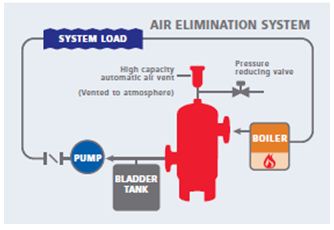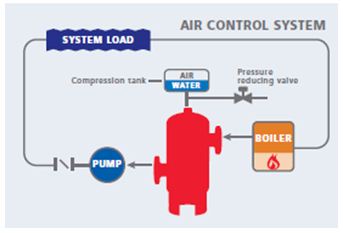Choosing to use a Bell and Gossett ASME bladder style expansion tank, ASME diaphragm style tank, or ASME standard compression tank in your hydronic system will depend on several factors. One important consideration in choosing which tank to use depends on the type of “air control” system you design.
If your design is an air elimination system, use a bladder or diaphragm tank. Air elimination systems depend on automatic air vents to continually remove the air from the hydronic system. The only air in the system will be in the tank and outside the bladder. Unless the tank is very small, I recommend our “B” style tank because the bladder is removable. The bladder or diaphragm is a moving part and may fail after a while. “D”: style diaphragm tanks have non-removable internals and would require you to remove and replace the entire tank. With the tight mechanical rooms we have today, that could present a challenge.
If your design is an air control system, use a standard ASME plain steel tank. Air control systems use manual vents. They may have automatic air vents in the system, but have shut off valves which are closed after commissioning. The only air in this type of system is in the compression tank.
You may notice my use of the term; expansion and compression tanks. Be careful because these are often used interchangeably in the HVAC industry but there is a technical difference. Expansion tanks have bladders or diaphragms and the water expands into the tank “balloon”. Compression tanks do not have bladders; the air in the tank compresses as the water expands into the tank. There is not much of a difference in these two definitions so be careful.
Disclaimer: R. L. Deppmann and it’s affiliates can not be held liable for issues caused by use of the information on this page. While the information comes from many years of experience and can be a valuable tool, it may not take into account special circumstances in your system and we therefore can not take responsibility for actions that result from this information. Please feel free to contact us if you do have any questions.
Archives – Click here for Past Articles



